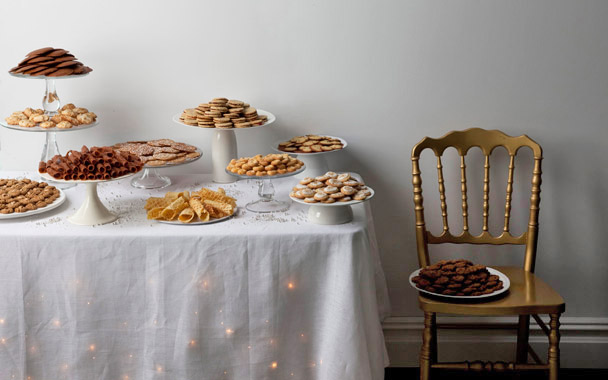I first heard about a cookie table when my niece was planning her own wedding in Pittsburgh. Family members and guests, I learned, were expected to show up bearing boxes of their favorite home-baked cookies, all to be displayed on a long banquet table. Everyone would help themselves after the ceremony and also take some cookies home as party favors. It all sounded charming but also a bit humble, like a card table laden with Snickerdoodles trying to upstage the fancier wedding cake.
I simply couldn’t understand the awe the custom inspired in these parts of western Pennsylvania and eastern Ohio—until I came face to face with the cookie table itself. It was a wonder, with acres of colorful baked treats, perhaps a couple thousand of them, each one more extravagant than the next. All were arranged like jewels on tiers of silver platters that had been carefully adorned with tulle and lace.
Liz Nohra, curator of a cookie-table exhibit at the local history museum in Youngstown, Ohio, traces the custom back to immigrants—mostly Italians, Eastern Europeans, and Greeks—who worked in the steel mills and perhaps couldn’t afford a wedding cake. As to where the custom originated—Youngstown or Pittsburgh—no one is certain. At Our Lady of Mount Carmel church, in Youngstown, it can take all day to set up a proper cookie table. The record number at one wedding, according to Lou Fusillo, who manages the catering for the church, is 15,000 cookies. People may notice the bride’s dress or and swoon at the flowers, he says, but it’s not a successful wedding until guests pronounce judgment on the table. “And there better be lots of cookies,” he adds.
Usually, the bride’s family does most of the baking, but everyone is welcome to pitch in. Bakers win points for creating bite-sized delicacies that come from family recipes, and the more difficult to make the better. The most popular cookie may be the ladylock, a flaky pastry horn with a silky cream filling. It’s also called a clothespin cookie, because grandmothers wrapped the pastry around a wooden clothespin that was later extracted to make space for the cream filling. Another favorite is the pizzelle, a flat wafer, round and lacy, like a snowflake, with a whisper of anise or lemon. And everyone loves the buttery Greek and Italian wedding cookies, dusted with powdered sugar, as well as the Czech kolaches, rolled leaves of dough that are either crispy with nuts or sweet and chewy with fruit.
There are wonderful tales of the angry aunt whose specialty wound up at the back of the display and a bride’s family fallen into disgrace when store-bought cookies turned up in the mix. But most of the lore surrounding the cookie table is about happy times. “It’s a way of bringing people into your celebration,” says Nohra, “sharing a heritage of family and food.” And the cookie table is spreading; she has tracked them not only to weddings but also to anniversary celebrations, graduations, showers, and baptisms as far away as West Virginia, Virginia, New York, New Jersey, and Delaware. I can vouch for one turning up in Connecticut. When I got married there last summer, my Pittsburgh relatives staged a cookie table full of our family favorites. The wedding cake made quite a splash, but it was the cookies that stole the show.



 Pinterest
Pinterest


